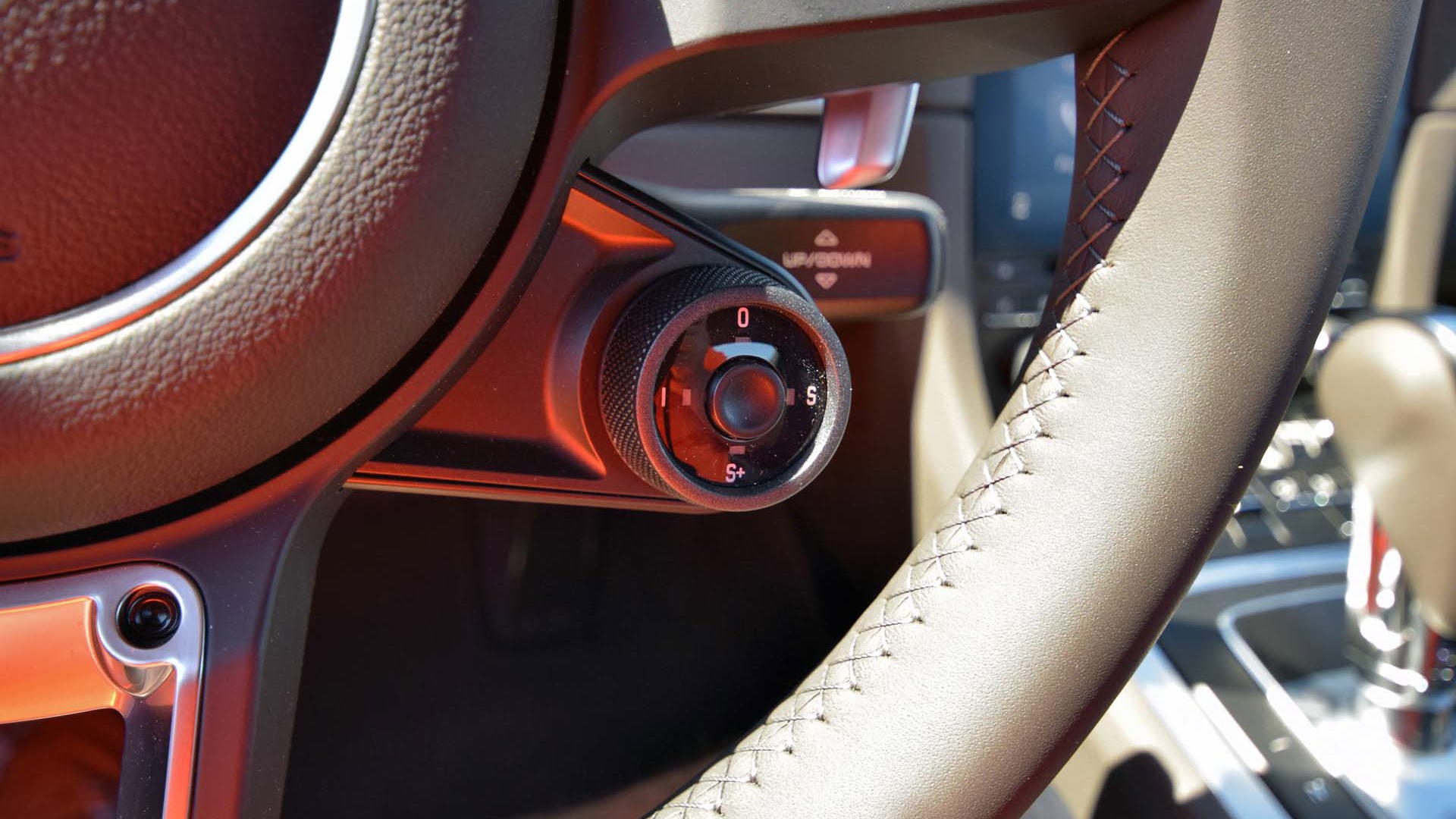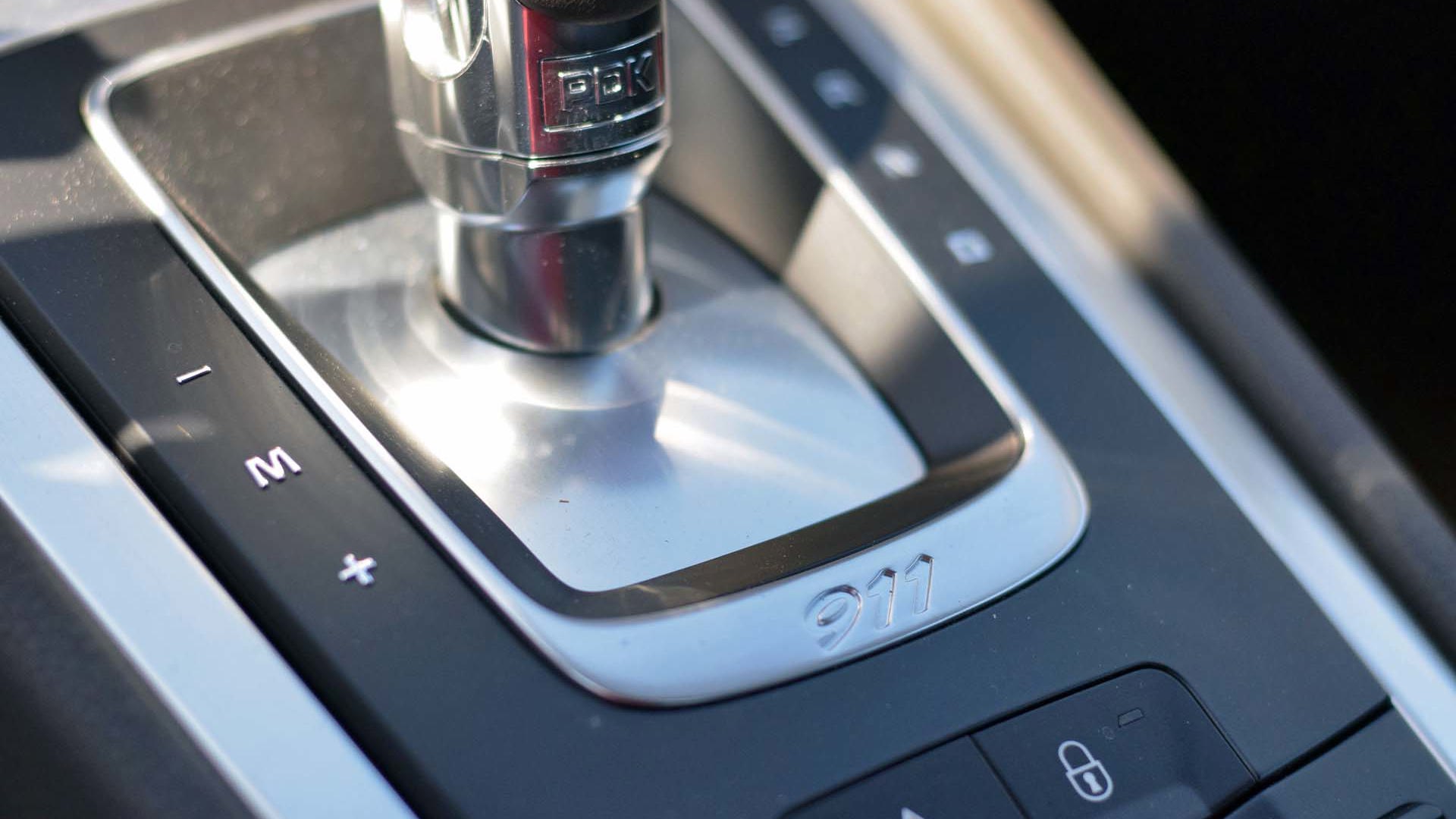 AutoTrader SCORE
AutoTrader SCORE
-
EXTERIOR STYLING6/10
-
INTERIOR8/10
-
PERFORMANCE8/10
-
COMFORT8/10
-
FUEL ECONOMY8/10
It’s not an unfamiliar reaction: pin the throttle in the 2017 Porsche 911 Carrera 4S, and the car leaps ahead, power swelling up as the tachometer reaches the upper half of its sweep, and swelling up some more as the 7,400 rpm redline approaches. Gears shift, via the PDK transmission, at an impossible speed, and with impossible precision that sees the tachometer’s needle flick around faster than your eyes can track it.
The 911 still sounds boss.
It’s all powered up by a twin-turbo 3.0L flat-six lump, with the bigger all-motor unit propelling many former 911 models now relegated to the history books. Downsizing and turbocharging has arrived in the 911’s engine bay, and there have been some concerns about what that sounds like.
Turbochargers sit in an engine’s exhaust stream, mucking up the pulsations of engine exhalation as the gaseous stream gets all mashed up and discombobulated as it’s fed through the turbines. Among other things, this smooths out the pulsations key to the signature sound of so many hot engines. As a result, it’s harder (though not impossible) to make a turbo engine sound magnificent, especially when it comes to a pulsating, throbbing, wailing or otherwise distinctive sound signature.
But, the 911 still sounds boss. Sports exhaust opened up with a click of the console-mounted button, and the sound is loud, progressive, provocative and pleasing. It soaks the cabin. It sounds thrilling. And though it lacks the all-out zing of last year’s all-motor setup, and the signature low-RPM boxer-engine rattle-clatter from the rear of the car, it’s still a performance soundtrack, and a Porsche performance soundtrack, through and through.
Where the former engine had a transformative sound that started with a hollow howl and melted into a nearly furious wail as the rev-limiter readied for action, the new engine’s tonal notes are more steady and smooth. The turbo engine transforms more in volume and less in terms of the sound itself, though there’s still a marked and direct connection between throttle position, revs, and what’s hitting your eardrums.
And you can hear the compressors, loud and clear, and especially in low-rev, high-load situations with a window cracked a little, to reflect the delightful sounds off of nearby infrastructure. That’s interesting, as engineers are capable of dialing these sounds out of the equation completely. Here, it seems they’ve embraced the 911’s new soundtrack, complete with the overlay of new whistle-hiss sound effects from behind the back bumper.
So that’s it. The heart, the core, the engine of the new 911 still fits the role – it just sounds a little different doing it.
Feels a little different, too. Turbochargers fill the power band with more thrust more of the time, and there’s more torque down low, more thrust up top, and a slightly more consistent and less peaky delivery of acceleration, though it’s still peaky nonetheless. According to my trousers, this still feels just like a 911, as I’ve always know them.
Here’s a slick bit: flick the drive mode dial into SPORT or SPORT + mode, and the boost gauge bumps to 1 or 2 psi, even if you’re off of the throttle. Some trick wastegate wizardry enables this slight pre-spooling of the turbines, making the minimal lag even less noticeable, and putting instant response that much closer to the tips of your toes. This is Porsche’s way of saying they care.
Other changes are subtle. Engine cover slats are now vertical, rather than horizontal, to whisk more air into the engine room for breathing, compressing and cooling. Mounted at the lowest rearward corners of the 911 are small, black ports which evacuate hot air from the intercoolers, themselves concealed by the body work, and used to pull heat out of the turbocharged air.
On board, there’s a new central command touchscreen system, and a slick one at that. Liquid-smooth responses, fast reactions, logical control layout, and Apple CarPlay functionality are all flaunted. The cabin exists with the same uniquely graceful and understated take on luxury and tech as others in the recent 911 range.
Let’s talk customization. Shoppers start with the standard or higher-performing “S” 911 model variants as the two core performance grades upon which to build, with 370 or 420 horsepower this year, respectively. Then you pick rear- or all-wheel drive, like the tester, and referenced by the ‘4’ in the name badge. There’s two- or four-wheel steering this year, and manual or automatic dual-clutch transmissions, catering to various desires for do-it-yourself operation or full manual control.
Then, you’ve got Coupe, Targa and Cabriolet body styles, matching various stylistic preferences, and an available Sport Chrono package pushing performance even higher for the power user.
It’s like pulling the perfect new digital camera from the shelf of your favorite retailer, and using it: select the style, feature sets, options, performance level and systems you need. Then, there’s no shortage of fine-tuning its operation to your preferences, in real time.
Fully automatic computer control, or full manual control? Like a digital camera’s ‘AUTO’ setting, constantly devising the perfect shutter speed and aperture combination for any situation, the 911’s PDK transmission intelligently meters gear selection against vehicle speed in all conditions, or can be flicked into a full manual mode, where the operator calls the shots for a custom performance driving image. In any case, gears are swapped in the same fraction-of-a-second speeds as a camera shutter.
There’s the now-standard Porsche Active Suspension Management (PASM) technology, using dampers that work constantly to fine-tune the ride and handling balance. Like the choice between a soft and forgiving image or a precise and hard-edged one, PASM allows drivers to change the feel of their performance picture on the fly. In normal mode, the 911 rides more like a sporty sedan. In Sport + mode, the body undulates tightly and urgently on its wheels, like the sort of coil-over-equipped compact import tuner car that’s typically trailered to the track for weekend lapping.
Available Porsche Dynamic Damper Control (PDDC) technology does for the 911 what an image stabilizer system does for a photographer using a pro lens: it keeps things steady, flat and centered on uneven ground or while moving quickly, and makes a precise and sharp image easier to access in challenging conditions. In a camera, it’s all about keeping lens internals steady. In the 911, it’s all about keeping the body flat on its wheels, almost no matter what, with benefits on the road, and on the track.
Other customizable systems can be dispatched in various levels, including traction and stability control and even exhaust volume. And though cameras deal little in sound and traction, they typically feature a mode-select dial, just like the one on the 911’s steering wheel, for instant, fingertip access to whatever array of settings you like. Just a click or twist switches things from full manual to full automatic, from preset to custom, and from a touring-ready Comfort mode, (not unlike your camera’s landscape setting) to a lighting fast Sport + mode, which is like putting your camera into its performance burst-shot setting.
That’s a lot of different systems, buttons, modes and parameters to keep track of, to be sure. And, in case you forget which mode and level the 911’s various systems are set to, there’s now an easy way to get things into maximum rocket-mode, in about 2/10ths of a second. Just click the Sport Response button, centered within the mode-select dial, and everything goes to 11, right now. Turbos pre-spool. The PDK shifts to the lowest possible gear. Revs leap towards the upper third of the central-mounted tachometer. A countdown timer engages. Just click it, then stuff your boot to the carpet, and it’s like being fired out of a cannon. This is your proverbial “push-to-pass” button, and it’s a fun bit of kit, designed to put full performance within easy, instant reach.
Another is the revised Launch Control function. This time around, provided you’re in Sport +, just hammer the throttle, fast to the floor, while you’re hard on the brakes. You get about 6,000 revs, pre-spooling of the turbos, and pre-splitting of the AWD torque distribution. Releasing the brakes hammers the clutch into action, and makes the C4S feel it’s been rear-ended by an 18-wheeler. You’ll get 0-60 in 4 seconds, every time you use it, with near-nil wheelspin and maximum charge at the road ahead. This is super-ideal technology if a Stingray gets all up in your business at a traffic light.
And though – in terms of handling, precision, grip and the attitude of the car – there are subtle differences between the combinations of equipment, it’s the similarities, in the 911’s native environment, the racetrack, that are easier to spot. Four-wheel steering models feel a little more sharp and frisky, two-wheel drive units with the ‘S’ powerplant feel a touch more greasy and easy to throttle-steer from the rear end, and units with the PASM suspension are less busy over their wheels at speed. But in any case, the 911 works with you, flatters you, encourages you, and never feels intimidating, or like it minds being driven hard and fast, all day long.
Instantaneous responses to all of your inputs, and a feeling of natural athleticism shine through, regardless of your 911’s configuration. Interestingly, on the track, fluid temperatures stay pegged within just a few degrees of where they’d be during a peaceful highway cruise, too, where so many other machines see the temperature gauges creeping towards the red-zone, lap after lap.
Whether you’re flattening your eyeballs with the Launch Control, engaging in an emergency brake-and-evade maneuver, or doing some lapping, there’s a refinement that shines through it all.
And, if a casual cruise is the order of the day, just flick it all off.
Of course, all of this engineering doesn’t come cheap. The tested Carrera 4S with 4-wheel steering and some options, came with a sticker of over $150,000, with the big engine, the four-wheel drive, the PDK transmission and a few other gadgets – all of which help create a picture perfect performance for its driver, or your lucky correspondent, for a few days at the wheel. This is cutting-edge performance motoring.
| Warranty: 4 years/80,000 km; 4 years/80,000 km powertrain; 12 years/unlimited distance corrosion perforation; 4 years/80,000 km roadside assistance Competitors: |
| Model Tested | 2017 Porsche 911 Carrera 4S |
|---|---|
| Base Price | $126,100 |
| A/C Tax | $100 |
| Destination Fee | $1,085 |
| Price as Tested | $152,155 |
|
Optional Equipment
GT Silver Metallic Paint ($820), PDK transmission ($3,660), PASM Suspension ($1,020), Adaptive Cruise ($2,850), 20-inch RS Spyder Wheels ($2,710), Lane Change Assist ($970), Power Sport Seats ($2,650), Sunroof ($1,700), Premium Package ($710), Rear Axle Steering and Sports Exhaust Package ($7,780)
|
|












































